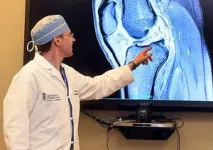(Press-News.org) In 1953, 15-year-old Joe Ligon and four other Pennsylvania teens went on an alcohol-fueled tear that resulted in the stabbing deaths of two people and injuries to six more.
The teens were tried as a group, and all received life without parole.
After a series of U.S. Supreme Court decisions in 2012 and 2016 found that mandatory life sentences for juveniles was unconstitutional, Ligon’s case went to federal court. After 67 long years in prison, the case was decided in his favor in 2020.
Ligon was granted his freedom in 2021 — at 83 years of age and after nearly seven decades behind bars. Soon after his release, J.Z. Bennett, a University of Cincinnati professor, criminologist and champion of criminal justice reform, got the chance to meet Ligon.
“Meeting Joe Ligon showed me how we have ignored this group of children, primarily Black children, sentenced to life without parole and treated them as outcasts in this country through their long-term incarceration,” says Bennett, an assistant professor of criminology at UC’s College of Education, Criminal Justice, and Human Services (CECH).
“We need to think about second chances for adults who were sentenced as children. To punish someone for life for what they did at 12 or 15 years old is stark,” he said.
According to Bennett, lead author on a journal article published in the Journal of Criminal Justice, there are 2,904 juvenile “lifers” (as they are called) spread across the U.S. penal system, ranging in age from 19 to 70 (the average age being 45) and a significant number were 13 or 14 at the time of the offense.
"This is groundbreaking data as it is the first time academic literature provides a national overview of this population,” says Bennett.
The journal article, he says, provides insight into a full demographic profile of the juvenile life without parole population. It is based on a three-year study conducted by Bennett and co-investigators at the University of California and Temple University. The study examined key outcomes such as resentencing, release statuses, mortality and exonerations.
Since the Supreme Court rulings, more than 2,500 individuals have been resentenced and more than 1,000 of those have been released, the research team found. Approximately 400 await resentencing.
The open-access extensive national study explored young people who are ultimately given a chance at freedom after having been sentenced to life in prison.
“Given the gravity of this issue and this being the first national analysis, we are just scratching the surface of what it means to provide equitable decarceration efforts for individuals with long sentences,” says Bennett.
Additionally, he says the research underscores that the U.S. is unique among developed nations in sentencing minors to life without parole. Bennett believes that practice conflicts with international human rights standards, such as those outlined in Article 37 of the United Nations Convention on the Rights of the Child.
“Substantial disparities [exist] among states in how they handle the resentencing and release of individuals sentenced to juvenile life without parole,” he says. For example, California has resentenced nearly all eligible individuals, while Alabama and North Carolina have much lower rates of resentencing and subsequent release.
The article notes the numerous challenges faced by juvenile lifers upon release, including limited access to housing and employment, health issues and the difficulties of adjusting to a society that has changed significantly during their incarceration.
There is a need for reexamining all “lifer” cases and providing comprehensive support systems where successful reintegration is emphasized, says Bennett.
As in the case of Ligon who served 68 years, “for the first time, men and women who were sentenced as children are returning to society, some after serving 30, 40 and even over 50 years.”
#
END
Many juvenile ‘lifers’ freed
UC criminologist and researchers compile study of persons under 18 sentenced to life without parole
2024-07-29
ELSE PRESS RELEASES FROM THIS DATE:
UW model shows cortical implants like Elon Musk’s Blindsight unlikely to ‘exceed normal human vision’
2024-07-29
Elon Musk recently declared on X that Blindsight, a cortical implant to restore vision, would have low resolution at first “but may ultimately exceed normal human vision.”
That pronouncement is unrealistic at best, according to new research from the University of Washington.
Ione Fine, lead author and UW professor of psychology, said Musk’s projection for the latest Neuralink project rests on the flawed premise that implanting millions of tiny electrodes into the visual cortex, the region of the brain that processes information received from the eye, will result in high-resolution vision.
For the study, ...
UVA's Data Justice Academy receives new funding from NSF
2024-07-29
The National Science Foundation will provide funding to the University of Virginia’s Data Justice Academy, the agency recently announced, support that will help the summer program continue to serve undergraduate students from groups that are historically underrepresented in data science.
Established in 2021, the Data Justice Academy provides a 10-week residential experience to participants in which they perform mentored research while learning technical skills.
The overriding goal of the Data Justice Academy, which is jointly managed by UVA’s School of Data Science and Equity Center, ...
Orthopedic surgeon-scientist Dr. Frank Henn named Chair of the Department of Orthopaedics
2024-07-29
University of Maryland School of Medicine (UMSOM) Dean Mark T. Gladwin, MD, announced today that R. Frank Henn, III, MD, Professor of Orthopaedics, who has served as Interim Chair of the Department since 2022, has been appointed to serve as the new Chair of UMSOM’s Department of Orthopaedics, effective immediately.
Dr. Henn, who joined the Department in 2010, is an academic leader and highly regarded, board-certified orthopaedic surgeon; he has published significant scientific research, and is a leading clinician focusing on the care of the shoulder and knee, with an emphasis in cartilage ...
Nature inspires a breakthrough: scientists develop revolutionary egg white-based bioink for advanced tissue engineering
2024-07-29
Los Angeles, California – July 29, 2024 - Terasaki Institute scientists have created a cutting-edge technology inspired by nature by developing a novel bioink derived from egg whites or Egg White methacryloyl (EWMA). Bioinks are mainly used in 3D bioprinting to create artificial tissues. These natural or synthetic materials support living cells, aiding their adhesion, growth, and differentiation. They are essential for developing complex tissue structures for medical research, drug testing, and organ transplantation. This novel EWMA bioink represents a promising addition to this field, offering a unique combination of properties that address many challenges faced in tissue engineering.
The ...
California a botanical and climate change hot spot
2024-07-29
From coastal redwoods and Joshua trees to golden poppies and sagebrush, California is a global botanical hotspot. It’s also a place confronted with extreme heat, wildfires and crumbling coastlines. The state’s natural beauty and history of pioneering conservation efforts make it a test bed for protecting biodiversity in the face of current and future climate change, argues a study led by the University of California, Davis.
Published July 29 in Proceedings of the National Academy of Sciences, the study, “Climate Change and California’s Terrestrial Biodiversity,” is part of a special ...
Young scientists face career hurdles in interdisciplinary research
2024-07-29
COLUMBUS, Ohio – Scientists agree that solving some of society’s greatest challenges in biomedicine such as food sustainability, aging and disease treatment will need researchers from a variety of scientific fields working together.
But a new study finds that the young scientists who most embrace interdisciplinary research face “career impediments” not seen in their peers who focus their work only within their own disciplines.
The results are troublesome and pose a “grave challenge” to efforts to increase interdisciplinary ...
New progress in research into malignant catarrhal fever in cattle
2024-07-29
A research team led by University of Liège scientists has published a groundbreaking study on malignant catarrhal fever (MCF). This disease is caused by the alcelaphine gammaherpesvirus 1 (AlHV-1), which infects its natural host, the wildebeest. This study sheds light on the mechanisms by which this virus, which is asymptomatic and latent in the wildebeest, causes an oligoclonal expansion of CD8+ T lymphocytes in cattle, leading to the development of MCF.
In 2013, the research team had already demonstrated (1) that malignant catarrhal fever (MCF), which is fatal in cattle, only develops if the AlHV-1 virus can maintain a ...
Words like ‘this’ and ‘that’ act as attention tools across languages
2024-07-29
All languages have words like ‘this’ and ‘that’ to distinguish between referents that are ‘near’ and ‘far’. Languages like English or Hebrew have two of these ‘demonstratives’. Languages like Spanish or Japanese use a three-word system. For instance, in Spanish, ‘este’ signals something close to the speaker, ‘ese’ signals something far from the speaker but close to the listener, and ‘aquel’ signals something far from both.
“The reason why we were interested in demonstratives is because of their ...
Local food production saves costs and carbon
2024-07-29
Local foods are critical to the food security and health of Indigenous peoples around the world, but local "informal" economies are often invisible in official economic statistics. Consequently, these economies may be overlooked in the policies designed to combat climate change. For instance, Indigenous communities in the North American Arctic are characterized by mixed economies featuring hunting, fishing, gathering and trapping activities, alongside the formal wage economy. The region is also undergoing a rapid transformation due to social, economic and climatic changes. In Canada, the introduction ...
Bold moves needed for California agriculture to adapt to climate change
2024-07-29
California should take urgent and bold measures to adapt its $59 billion agriculture sector to climate change as the amount of water available for crops declines, according to a collaborative report by University of California faculty from four campuses.
Published in the Proceedings of the National Academy of Sciences, the report provides a roadmap for more water capture, storage, and distribution systems that are in harmony with climate projections and ecosystems. It further considers how runoff and groundwater can be used repeatedly ...
LAST 30 PRESS RELEASES:
University of Oklahoma researcher awarded funding to pursue AI-powered material design
Exploring how the visual system recovers following injury
Support for parents with infants at pediatric check-ups leads to better reading and math skills in elementary school
Kids’ behavioral health is a growing share of family health costs
Day & night: Cancer disrupts the brain’s natural rhythm
COVID-19 vaccination significantly reduces risk to pregnant women and baby
The role of vaccination in maternal and perinatal outcomes associated with COVID-19 in pregnancy
Mayo Clinic smartwatch system helps parents shorten and defuse children's severe tantrums early
Behavioral health spending spikes to 40% of all children’s health expenditures, nearly doubling in a decade
Digital cognitive behavioral treatment for generalized anxiety disorder
Expenditures for pediatric behavioral health care over time and estimated family financial burden
Air conditioning in nursing homes and mortality during extreme heat
The Alps to lose a record number of glaciers in the next decade
What makes a good proton conductor?
New science reporting guide published for journalists in Bulgaria
New international study reveals major survival gaps among children with cancer
New science reporting guide published for journalists in Turkey
Scientists develop a smarter mRNA therapy that knows which cells to target
Neuroanatomy-informed brain–machine hybrid intelligence for robust acoustic target detection
Eight SwRI hydrogen projects funded by ENERGYWERX
The Lundquist Institute and its start-up company Vitalex Biosciences Announces Strategic Advancement of Second-Generation fungal Vaccine VXV-01 through Phase 1 Trials under $40 Million Competitive Con
Fine particles in pollution are associated with early signs of autoimmune disease
Review article | Towards a Global Ground-Based Earth Observatory (GGBEO): Leveraging existing systems and networks
Penn and UMich create world’s smallest programmable, autonomous robots
Cleveland researchers launch first major study to address ‘hidden performance killer’ in athletes
To connect across politics, try saying what you oppose
Modulating key interaction prevents virus from entering cells
Project explores barriers to NHS career progression facing international medical graduates
Jeonbuk National University researchers explore the impact of different seasonings on the flavor perception of Doenjang soup
Two Keck Medicine of USC Hospitals named Leapfrog Top Teaching Hospitals
[Press-News.org] Many juvenile ‘lifers’ freedUC criminologist and researchers compile study of persons under 18 sentenced to life without parole









